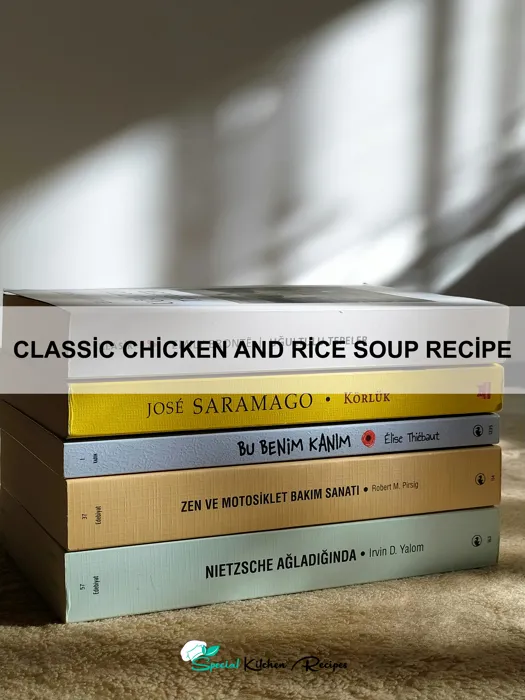Chicken and rice soup, a seemingly simple dish, boasts a rich and varied history, far exceeding its humble ingredients. While pinpointing a single origin is impossible, its foundational elements – chicken broth, rice, and vegetables – have been staples in diverse cultures for millennia. Ancient civilizations, from the Greeks and Romans to the Egyptians, utilized variations of this comforting concoction, relying on readily available ingredients and utilizing their inherent medicinal properties. The exact recipe, however, evolved over time, shaped by regional availability and cultural preferences. The combination of easily accessible ingredients and its restorative qualities led to its widespread adoption.
The soup’s modern iteration likely emerged from European traditions, particularly those of Jewish and Italian cuisines. Jewish penicillin, a fond nickname reflecting its perceived healing powers, became a popular home remedy passed down through generations. This emphasizes the soup’s role not just as nourishment, but as a source of comfort and recovery during illness. Italian variations, often featuring more robust vegetables and herbs, contribute to the soup’s global popularity. Interestingly, a 2019 survey found that chicken soup was ranked amongst the top three most frequently consumed comfort foods in the United States, highlighting its enduring appeal across generations and cultures.
The cultural significance of chicken and rice soup is undeniable. It transcends simple sustenance; it represents nurturing, care, and tradition. Many associate it with childhood memories, home-cooked meals, and the comforting presence of family. It’s a dish often prepared during times of illness or emotional distress, providing both physical and emotional nourishment. Beyond the home, this soup has found its place in various cuisines and restaurants worldwide, constantly adapting and evolving while retaining its core characteristics. Its versatility allows for endless variations, from spicy versions featuring chili peppers to creamy additions like milk or coconut milk, showcasing its adaptable nature and global reach.
Ingredients and Measurements
This Classic Chicken and Rice Soup recipe yields approximately 8 servings of comforting goodness. Accurate measurements are crucial for achieving the perfect balance of flavors and textures. We recommend using a kitchen scale for the most precise results, especially when measuring the rice and vegetables. However, volume measurements are provided as an alternative.
Chicken: 1.5 lbs boneless, skinless chicken breasts. You can substitute with bone-in chicken thighs for a richer broth, but adjust cooking time accordingly. Ensure the chicken is fresh and of good quality for the best flavor. Consider using organic chicken for a healthier option.
Broth: 8 cups low-sodium chicken broth. Using low-sodium broth allows you to control the salt level and avoid an overly salty soup. You can easily substitute with homemade chicken broth for a deeper, more nuanced flavor. Homemade broth adds a significant depth of flavor, but takes longer to prepare.
Aromatics: 1 medium yellow onion, finely chopped; 2 carrots, peeled and diced; 2 celery stalks, diced. The aromatics form the base of the soup’s flavor profile. Ensure the vegetables are finely diced for even cooking and to prevent large chunks in the final product.
Rice: 1 cup long-grain white rice, rinsed. Rinsing the rice removes excess starch, which helps prevent the soup from becoming gummy. Long-grain rice holds its shape better than short-grain in this recipe. Alternatively, you can use 1 cup of Arborio rice for a creamier texture, but it may absorb more liquid.
Seasoning: 2 cloves garlic, minced; 1 teaspoon dried thyme; 1/2 teaspoon dried rosemary; 1/4 teaspoon black pepper; Salt to taste. Adjust the seasoning to your preference. Start with a smaller amount of salt and add more at the end, as the broth may already contain some sodium. Fresh herbs can be substituted for dried herbs, but use approximately 1/3 the amount.
Other Ingredients: 1/4 cup chopped fresh parsley (for garnish); 1 bay leaf (removed before serving). The bay leaf adds a subtle depth of flavor to the broth. Remember to remove it before serving, as it can be slightly bitter if consumed whole. Fresh parsley brightens the soup’s appearance and flavor.
Optional additions: Consider adding other vegetables such as diced potatoes, green beans, or peas. You could also add a bay leaf for a more complex flavor profile. Remember to adjust cooking times accordingly if adding other vegetables.
Preparation of Chicken and Vegetables
Begin by preparing the chicken. We’ll use about 1.5 lbs of bone-in, skin-on chicken thighs for this recipe. Bone-in chicken adds more flavor to the broth, and the skin renders delicious fat that enriches the soup. Rinse the chicken thighs thoroughly under cold water and pat them dry with paper towels. This step helps to remove any impurities and ensures even browning.
Next, let’s prepare the vegetables. We’ll need a medley of flavors to create a truly classic chicken and rice soup. Start by chopping 1 medium yellow onion into roughly ½-inch dice. A sharp knife and a steady hand are key here for consistent size. Then, finely mince 2 cloves of garlic. Mincing the garlic allows its flavor to infuse the broth more effectively. Don’t be afraid of a generous amount of garlic; it’s a cornerstone of this recipe’s flavor profile.
Now for the carrots and celery. Chop 2 medium carrots and 2 stalks of celery into ½-inch pieces. Consistent sizing ensures even cooking. If you prefer a smoother texture, you can opt for smaller dice. For a more rustic look, slightly larger pieces will work perfectly.
Proper preparation of the vegetables is crucial for achieving optimal flavor and texture. Avoid over-chopping, as this can lead to mushy vegetables in the final soup. It’s better to err on the side of slightly larger pieces to maintain a pleasant bite.
Finally, prepare any additional vegetables you might wish to add. This recipe is easily customizable. Consider adding 1 cup of chopped leeks for a more sophisticated flavor, or ½ cup of diced parsnips for sweetness. Remember to wash all vegetables thoroughly before chopping to remove any dirt or debris.
Once all the chicken and vegetables are prepped, you are ready to move on to the next stage of the recipe. Proper mise en place (everything in its place) is essential for efficient and stress-free cooking. Having all your ingredients prepared before you begin cooking will ensure a smooth and enjoyable cooking experience.
Sautéing Aromatics
Sautéing the aromatics is the crucial first step in building a deeply flavorful chicken and rice soup. This process unlocks their inherent sweetness and complexity, creating a rich foundation for the entire dish. We’ll be using a classic combination of onion, carrots, and celery, often referred to as the mirepoix. Accurate measurement is key here for achieving the right balance of flavors.
Begin by finely dicing one medium yellow onion (approximately 1 cup diced). Ensure your dice is consistent; even-sized pieces will cook evenly. Next, peel and finely dice two medium carrots (about 1 cup diced). Again, aim for uniformity. Finally, finely dice two celery stalks (about 1/2 cup diced). You can use a food processor for speed, but hand-dicing allows for more control over the size and texture.
Heat 2 tablespoons of olive oil in a large, heavy-bottomed pot or Dutch oven over medium heat. A heavy pot retains heat evenly, preventing burning and ensuring even cooking. Once the oil shimmers, add the diced onion to the pot. Cook, stirring occasionally, for about 5-7 minutes, until the onions soften and become translucent. Don’t rush this step; properly softened onions contribute significantly to the soup’s flavor.
Add the diced carrots and celery to the pot and continue to sauté for another 5-7 minutes, stirring occasionally. The vegetables should soften slightly and begin to release their natural sugars. Season lightly with salt and freshly ground black pepper at this stage. This helps to draw out moisture and enhance the flavors of the vegetables. A pinch of salt (about 1/4 teaspoon) and a few grinds of black pepper are sufficient.
Avoid overcrowding the pot. If necessary, sauté the vegetables in two batches to ensure even cooking and browning. Overcrowding will lead to steaming instead of sautéing, resulting in less flavorful vegetables. Once the vegetables are tender and slightly softened but still retain some bite, you’re ready to proceed with the next step of the recipe. The aromatics should be fragrant and slightly sweet, not browned or burnt.
Simmering the Soup
Once you’ve sautéed the vegetables and added the chicken broth, it’s time to simmer the soup to perfection. This crucial step allows the flavors to meld and the chicken to become incredibly tender. Begin by bringing the entire pot of soup to a gentle boil over medium-high heat. You should see small bubbles rising steadily to the surface. Once boiling, immediately reduce the heat to low, ensuring a consistent simmer.
Maintain a low simmer – this is key! A rolling boil will make the soup cloudy and potentially overcook the chicken, resulting in a tough and dry final product. A gentle simmer, characterized by a quiet bubbling, is ideal for extracting maximum flavor from the ingredients and creating a rich, flavorful broth.
Cover the pot partially with the lid. This allows some steam to escape, preventing the soup from becoming overly watery, while still retaining enough moisture to keep the ingredients tender. Simmer the soup for at least 30 minutes, or up to 45 minutes, depending on the size and type of chicken pieces you’re using. Smaller diced chicken will cook faster than bone-in pieces.
During the simmering process, it’s a good idea to skim the surface of the soup occasionally. This will remove any foam or impurities that may rise to the top, resulting in a clearer, more appealing broth. Use a large spoon to gently scoop away any unwanted debris. Don’t stir excessively, as this can break down the vegetables and make the soup less visually appealing.
After 30-45 minutes, check the chicken for doneness. It should be easily shredded with a fork. If it’s not quite ready, continue simmering for another 10-15 minutes, checking periodically. Once the chicken is cooked through, remove the pot from the heat. Allow the soup to rest for at least 10 minutes before shredding the chicken and stirring in the rice. This resting period allows the flavors to deepen and the soup to thicken slightly.
Remember to taste and adjust seasoning before serving. You might need to add a little more salt, pepper, or other herbs and spices to achieve your desired level of flavor. A squeeze of fresh lemon juice at the end can also brighten up the taste and add a touch of acidity that complements the richness of the soup.
Cooking the Rice
The success of your chicken and rice soup hinges significantly on perfectly cooked rice. We’ll be using long-grain white rice for this recipe, as it holds its shape well in the soup and doesn’t become mushy. You can, of course, experiment with other types, but adjust cooking times accordingly.
Begin by measuring out 1 cup of long-grain white rice. Rinse the rice thoroughly under cold running water in a fine-mesh sieve. This crucial step removes excess starch, preventing the rice from becoming sticky and clumpy in the soup. Continue rinsing until the water runs clear.
In a medium saucepan, combine the rinsed rice with 2 ½ cups of chicken broth (reserved from cooking the chicken, if possible, for maximum flavor!). You can also use water, but broth significantly enhances the overall taste. Add a pinch of salt to season the rice during cooking.
Bring the mixture to a rolling boil over high heat. Once boiling, immediately reduce the heat to the lowest setting, cover the saucepan tightly with a lid, and simmer for 18-20 minutes, or until the rice is tender and most of the liquid is absorbed. Do not lift the lid during this process, as this will release steam and prevent the rice from cooking evenly.
After 18 minutes, carefully check the rice for doneness. It should be tender but still have a slight bite to it. If it needs a little more time, continue simmering for another couple of minutes, checking frequently. If the rice is done but there’s still excess liquid, you can increase the heat slightly to evaporate the extra moisture.
Important Note: Overcooked rice will become mushy and ruin the texture of your soup. Undercooked rice will be hard and unpleasant to eat. Therefore, precise timing and attention to the cooking process are key. Once cooked, remove the saucepan from the heat and let the rice sit, covered, for 5 minutes before fluffing it gently with a fork. This allows the rice to finish cooking and absorb any remaining liquid.
Once the rice is cooked and fluffy, it’s ready to be gently stirred into your simmering chicken soup. Avoid over-stirring, as this can break up the rice grains. Let the rice cook in the soup for another 5-10 minutes to allow the flavors to meld together completely before serving.
Seasoning and Flavor Adjustments
Seasoning is crucial for a truly delicious chicken and rice soup. While the base recipe provides a solid foundation, feel free to adjust seasonings to your personal preference. Start with a light hand and taste frequently, adding more as needed. This prevents over-seasoning, a common mistake that can easily ruin the delicate flavors of the soup.
Salt and pepper are the cornerstones of any good soup. Begin by adding 1 teaspoon of salt and ½ teaspoon of freshly ground black pepper to the pot after the chicken is cooked and shredded. Taste the broth and adjust accordingly. Remember that salt intensifies other flavors, so adding more at the end is often better than adding too much initially. Consider using kosher salt, which is less salty by weight than table salt, for better control.
For extra depth of flavor, consider adding 1 teaspoon of dried thyme or rosemary. These herbs complement the chicken beautifully and add a warm, earthy note. If using fresh herbs, use approximately 2 tablespoons, finely chopped. Fresh herbs always offer a more vibrant flavor, but dried herbs are a convenient alternative.
Garlic powder and onion powder are fantastic additions for those who want to boost the savory notes without adding additional ingredients. Start with ½ teaspoon of each and adjust to taste. If using fresh garlic and onion, sauté them in butter or oil for a few minutes before adding the chicken broth for a richer flavor. Aim for about 2 cloves of garlic, minced, and ½ a medium onion, finely chopped.
A squeeze of lemon juice at the very end (about 1 tablespoon) brightens the flavors and adds a touch of acidity that cuts through the richness of the chicken and broth. Avoid adding lemon juice too early, as it can become bitter with prolonged cooking.
For a spicier kick, add a pinch of cayenne pepper or a few dashes of your favorite hot sauce. Start with a small amount and increase gradually, as the heat can easily overpower the other flavors. A pinch of red pepper flakes offers a milder heat than cayenne.
Finally, don’t be afraid to experiment! Consider adding other herbs and spices such as bay leaves, parsley, or even a dash of Worcestershire sauce to personalize your soup. The best chicken and rice soup is the one you enjoy the most, so taste and adjust until you achieve your perfect balance of flavors.
Recommendations for Classic Chicken and Rice Soup
This Classic Chicken and Rice Soup recipe is a hearty and comforting meal, perfect for a chilly evening or when feeling under the weather. For optimal flavor, we recommend allowing the soup to simmer for at least 30 minutes to allow the flavors to meld together. Don’t be afraid to adjust the seasoning to your personal preference; a squeeze of fresh lemon juice at the end can brighten the flavors beautifully.
Serving Suggestions: This soup is delicious on its own, but you can elevate the experience with a variety of accompaniments. A crusty bread roll or a slice of cornbread is a classic pairing. For added protein and texture, consider topping with shredded cooked chicken, a dollop of plain Greek yogurt or sour cream, or a sprinkle of fresh herbs like parsley or chives. A side salad with a light vinaigrette would also complement the richness of the soup.
Storage: Leftovers can be stored in an airtight container in the refrigerator for up to 4 days. Allow the soup to cool completely before refrigerating to prevent bacterial growth. You can also freeze the soup for up to 3 months. Thaw overnight in the refrigerator before reheating gently on the stovetop or in the microwave.
Complementary Dishes: This soup is incredibly versatile. It pairs well with grilled cheese sandwiches, simple green salads, or even a light pasta dish. For a more substantial meal, serve it alongside a roasted vegetable medley like carrots, broccoli, and potatoes. The possibilities are endless!
Nutritional Information (per serving, approximate): These values are estimates and will vary depending on the specific ingredients used. Calories: Approximately 250-300. Protein: 20-25g. Fat: 5-8g. Carbohydrates: 30-40g. Sodium: Varies greatly depending on the type of broth used and added salt. For a lower sodium option, use low-sodium broth and season carefully. Note: This nutritional information is a guideline only. For precise nutritional values, use a nutrition calculator and input your specific ingredients and quantities.
Enjoy your delicious and wholesome Classic Chicken and Rice Soup!





